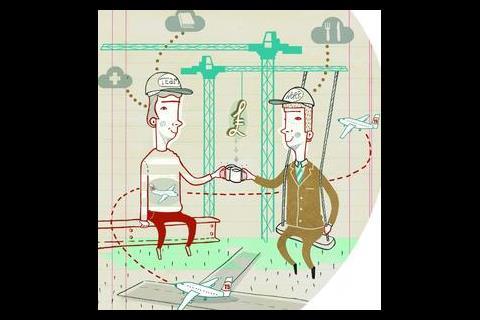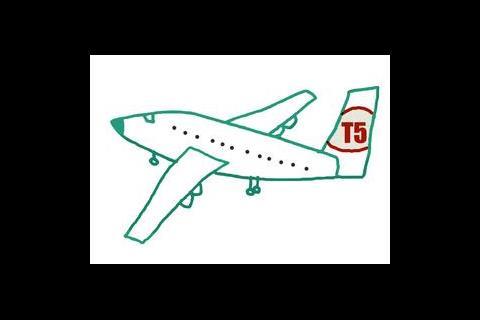BAA knew that its hugely ambitious £4bn Terminal 5 project ran the risk of becoming yet another notorious construction overspend. So it told all its contractors to work together as one – and lo and behold, they actually listened.
When airport operator BAA decided to go ahead with the construction of its new terminal, it was acutely aware that, in the past, construction inefficiencies had cost it too much. It was also aware that problems with mega-projects such as London Underground’s Jubilee Line extension and the Channel Tunnel had badly damaged other clients’ reputations.
More ominously, the airport operator knew that it could not afford for Terminal 5’s costs to get similarly out of control: its business has a value of about £5.5bn and the new terminal is forecast to cost in the region of £4bn. “When you look at BAA’s market capitalisation and the cost of T5, it was important that we understood why these mega-projects [the Jubilee Line extension and the Channel Tunnel] failed so that we could do something to buck the trend,” Matthew Riley, T5’s commercial director, explains.
Clearly a new approach to construction was needed if T5 was not to become yet another notorious construction project. BAA’s solution was to rethink the client’s role and to take responsibility for all risk on the project. “Most contracts look at what-if scenarios once a failure has occurred; we wanted to have a far more active engagement in managing risk,” explains Riley. And so the T5 agreement was born.
The idea for the agreement emerged in the 1990s while plans for the new terminal were being scrutinised under the UK’s longest-running public enquiry. “We did a lot of research around mega-infrastructure projects – costing more than £1bn – that had run over both time and budget and we found that their problems resulted from behavioural failure rather than technical failure,” says Riley. In other words, firms were spending more time protecting their own interests than those of the client.
Under the terms of the T5 deal, BAA has taken out a single insurance policy to cover the whole of the multibillion pound project. Because BAA has shouldered all the risk, it expects its suppliers to work together in an integrated team. Riley says it was “unrealistic” in any case for suppliers to take out insurance to cover a £4bn project.
In an integrated environment it is almost impossible to apportion blame to an individual; instead it is down to the supply chain to identify risks and to put in place contingencies. Executives are asked to lose their company allegiances and to work together, sharing information with colleagues in other professions in a “virtual” company. “The idea is to have the best brains in all companies working on solutions to problems on the project and not working on how best to defend their corner in court,” says Riley.
This concept has already been shown to work on the project: when bad weather delayed work on the main terminal’s substructure, it resulted in the team falling 14 weeks behind schedule. Instead of preparing claims for delays, the stakeholders sat down together and worked out the best way to get the programme back on track. As a result, the substructures were handed over on time.
One of the main reasons the agreement has been embraced by the supply chain is that BAA ringfences its contractor’s profits. Open book accounting is used, along with an agreed target cost and programme time for each phase of the project. However, if a team works well together and the job is delivered for less money or over a shorter period of time, there is an opportunity to increase margins further by translating these savings into higher margins.
John Morgan, director of Wise Management Services, is working with Amec on the services for the main terminal building. He says the T5 agreement has “de-badged” people to create a collaborative working environment. “In a normal situation, if one team had a problem, they would not put it on the table because another team would then claim for a delay as a result of that problem,” he says. However, at T5, it is different: “Because everybody has to take ownership of the project, issue resolution is a lot easier, which means that people are encouraged to raise issues at the first opportunity so that the team can come up with the best solution.”
A key part of the T5 agreement is that each supplier and contractor must sign up to be entirely open in its business dealings. “We demand complete transparency,” Riley says. As a result, contractors such as Balfour Kilpatrick, Crown House Engineering, Amec, Novar Projects and Hotchkiss Ductwork share information with each other even though they are working on different parts of the project.
Not only does this lead to a more integrated approach to the project, it has also allowed the firms involved to pool their purchasing power by forming a buy club. This has secured them discounts on products, such as 10% on cabling and up to 30% for design intensive items such as low-voltage switchgear. “The buy club is a consequence of the environment we’ve created; it secures continuity of supply by giving the supplier a more robust plan of volumes so that they can plan their production and logistics,” explains Riley (see “T5’s buy club”).
The T5 agreement has been in place now for well over a year and from the client’s perspective it appears to be working well. “The principles of the T5 agreement have not changed over the duration of the project,” says Riley. “However some of the policies around it have evolved, such as the industrial relations on the project.”
In fact the agreement has worked so well that visitors from other industries have been flocking to the site to see how one of the biggest shake-ups in the management of procurement in a generation is working. “We’ve had visits from the Ministry of Defence, the nuclear industry, the property industry, aerospace and shipbuilding,” says Riley.
T5’s buy club
At T5, there are five M&E contractors working on various projects for the new terminal. Before the buy club was initiated, each contractor would be buying the same, or similar, products and services for the £600m of work. Now they have pooled their expertise and buying power to secure one supplier for each commodity across all 16 services projects at Heathrow. Maya Jani, BAA’s team leader for the M&E buy club, says that this has allowed the contractors to achieve better commercial terms and standardises suppliers to simplify maintenance.
Currently there are 13 specialist buying teams purchasing items such as pipework, valves and pumps, lighting and lighting controls, ductwork and cables.
To buy a product each club must go through the same 12 steps:
- Obtain technical information to produce benchmark designs for equipment
- Pre-qualify suppliers through visits to design and production facilities
- Prepare an acquisition plan to cover items such as the procurement method, form of contract, payment method and programme milestones
- Prepare the tender enquiry
- Issue tender
- Carry out mid-bid interviews with each bidder
- Evaluate bids
- View suppliers’ presentations
- Prepare a recommendation report
- Place orders
- Give feedback to unsuccessful bidders
- Appoint a package champion to follow the package through its delivery.
Source
Building Sustainable Design
























No comments yet